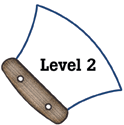
Alaska Science
Key Element A11
A student who meets the content standard should understand that similar features are passed on by genes through reproduction (Heredity).
 |
Alaska Science A student who meets the content standard should understand that similar features are passed on by genes through reproduction (Heredity). |
|
Performance Standard Level 2, Ages 8–10
|
|
|
|
Sample Assessment Ideas
|
Standards Cross-References
|
||
|
National Science Education Standards Plants and animals closely resemble their parents. (Page 129) Many characteristics of an organism are inherited from the parents of the organism, but other characteristics result from an individual’s interactions with the environment. Inherited characteristics include the color of flowers and the number of limbs of an animal. Other features, such as the ability to ride a bicycle, are learned through interactions with the environment and cannot be passed on to the next generation. (Page 129) The characteristics of an organism can be described in terms of a combination of traits. Some traits are inherited and others result from interactions with the environment. (Page 157) |
Benchmarks Some likenesses between children and parents, such as eye color in human beings, or fruit or flower color in plants, are inherited. Other likenesses, such as people’s table manners or carpentry skills, are learned. (Page 107) For offspring to resemble their parents, there must be a reliable way to transfer information from one generation to the next. (Page 107) |
|
Table of Contents | Return to Alaska Native Knowledge Network